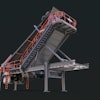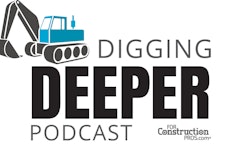
Upgrading your fleet is an important way your company can stay competitive. With new equipment, comes new technologies and enhancements that help members of your crew work more comfortably and more efficiently.
When it comes to asphalt rollers and road compaction, technology has been increasing steadily for years, improving performance and increasing the value of these machines on the jobsite. Rollers have been adapted to keep up with regulations, operator demand and with the ways our roads are being designed.
"Innovation is an ongoing process on with our equipment," Tim Kowalski, HAMM application support manager with Wirtgen America says. "We're always listening to contractors and changing our machines based on what they are saying and what their needs are. We're also changing the rollers to support the mix designs, the traffic loads, the type of materials, the oils that we're using and everything else that is changing.
"In order to get the same kind of performance of the mixes that we're developing and putting out there on the roadways, we're not going to be able to compact them the same way," Kowalski continues. "So understanding that we have to think a little bit more outside of the box of how we're going to develop a roller to give us better compaction, faster compaction, longer lasting roads is what we're continually working on."
Intelligent Compaction As Standard
One technology that has been progressing over the years is Intelligent Compaction (IC). These systems feature an accelerometer-based measurement system, as well as GPS, infrared temperature sensors, and an on-board computer that provides real-time compaction information to the operator. There have been many advancements in IC over the past few years aimed at reducing the guesswork in the paving process but many contractors still have not adopted this technology. As a result, manufacturers are continually evolving these systems to meet contractor needs.
"Contractors what things simple," Kowalski says. "Engineers have a tendency to say, well, if I touch these 10 buttons to do one thing, that's great. But contractors want to touch one button that does 10 things. Our operations need to be that simple and intuitive for the operators if we want them to use the equipment effectively."
What is evolving then is the idea of "Sophisticated Simplicity" to help contractors with their jobsite demands and need to efficiency when using the machine.
"The rollers are getting more and more sophisticated and we want to make it more simple for the operators to operate while also helping them to take guess work out of compaction." Vijay Palanisamy, director of product marketing and communications at Dynapac North American says. "For example in our large asphalt rollers we have standard intelligence built in for asphalt temperature and impact spacing which provides basic intelligence for operators without lot of investment. This allows operators to compact at the right speed and also right temperatures."
With the addition of Dyn@lyzer intelligent compaction system now the operator can get the full benefit of pass count, mapping of the job site and also stiffness readings which can be co-related to density.
"This further helps both contractors and DOT’s to make sure the roller operator has completed the job at hand with specific boundary conditions and providing continuous feedback while performing the task," Palanisamy continues. "This is what we call as Sophisticated Simplicity. The technology sophistication simplifies the operation of the roller."
Even with simplified controls, these systems are seen as complicated and adoption doesn't happen until necessity; when a contractor is required to use the technology on a project or when circumstances demand it.
"Many customers have been hitting their density numbers for years because they have an experienced crew and there is consistency in their process," Brian Nagel, global sales consultant for technology & utility compactor at Caterpillar, Inc. says. "When one of those or one of the many other factors change, they could go from hitting density to missing it which could be very costly. A few misses in a paving season usually has that customer asking what they can do to prevent it and one solutions is intelligent compaction. When a roller operator can start visualizing what they are doing, changes can be made to improve results.
And many times contractors need help getting started on the path to full IC.
"Many contractors still are not using intelligent compaction unless their project or DOT is mandating them to do so," Mark Eckert, global product manager at Volvo says. This is mainly because contractors are still unsure of the benefits and the systems have notoriously been seen as difficult to use and expensive to implement. We recently launched Compact Assist Start to help customers take the first step into Intelligent Compaction. It's easy to use and with no setup required, it includes pass mapping and temperature mapping functionalities, providing the operator with real-time data about how the job is progressing and is cheaper than a full blown IC system."
Another added benefit of IC? The "CYA" factor. Many projects are going to begin to require pass mapping documentation for density and IC gives contractors the assurance they completed the correct number of passes on each job.
"The documentation side of things can also be used to evaluate what was planned for a job and what was done to identify areas for improvement," Nagel adds. "This might mean training for roller operators on proper turnouts to ensure coverage in transition areas or the temperature maps might show inconsistency in paver speed which can lead to inconsistent density. By providing more information to our customers, it allows them to make better decisions and be more consistent with their final product."
Safety & Comfort Paramount
We all know that what's on the equipment is not as important as what's in it. Your people are paramount to your business and equipment is adapting to keep up with the challenging workforce demands our industry is facing.
"Many customers are facing challenges with finding operators and often the operators they do have may not have in depth experience," Nagel says. "The more we can do as a manufacture to make these machines easier to use, the more successful operators will be and machine operators are a big focus when Caterpillar designs machines."
We know that an operator who enjoys running a machine is more likely to be more productive and come back the next day so a huge emphasis has been placed on making these machines easy to operate and comfortable.
"This can be seen with customers who are choosing to buy machines with cabs to provide their operators with a more comfortable environment which makes employee retention easier," Nagel adds. "Our new line of asphalt compactors have the ability to slide the full operator station left to right on the machine and rotate 360º. This gives the operator the ability to position their body in the direction most natural for the work they are doing and reduces strain. Along with this positioning are controls strategically placed within the operator’s zone of comfort. The machine’s steering control, for instance, is done by a unique hand wheel that is comfortable and easy to use and can be positioned in two different locations depending on operator preference."
Another focus is consistency across different machines in the fleet. The ability to be able to run many different machines in the fleet is a huge advantage to operator-strapped companies.
"The HAMM Easy Drive system is a common operator station, from machine to machine so that the operator doesn't have to re-learn a dashboard when he's trying to run a machine," Kowalski says. We have over 195 models of rollers and if you know three dashboards, you know, every one of our rollers making it easy to go from machine to machine as all the buttons are in the same place as they are in any other machine."
When an operator is working, comfort isn't the only factor to consider. They also need to be safe, and keep those around them safe. Equipment is being upgraded to help with more ergonomically placed operator stations, backup cameras and object detection sensors.
"Collision avoidance and sensors are going to become more prominent," Eckert says. "Contractors are very conscious of work zone safety and as much technology that we can get that can make machines and job sites safer is one of more important things that we can do as manufacturers. The process of building a road isn't going to change anytime soon so it's important for all of us to work together and try to be as efficient as we can, and as safe as we can while we do it."
Is The Future Electric & Autonomous?
The short answer is yes. Cars, machines, construction equipment and more are all moving to electric operation that can operate autonomously. The path to getting there for out industry however is going to be a long one. Still, the future needs to look different to comply with changing carbon emission regulations.
"ECO responsibility is a key area of focus for Dynapac and we designed several technologies in to our rollers to reduce carbon footprint even with diesel powered units," Palanisamy says. "Dynapac's Patented efficient eccentric system reduces the power consumption up to 50% when the vibration is activated. Also our Intelligent EcoMode continuously manages engine RPM based on the loads reduces up to 15% in fuel."
Future machines are evolving to take sustainability even further.
"Everybody's looking at autonomous rollers, more remote control, electric-driven, those are in the works," Kowalski says. "The biggest thing is, how long is it going to last? How long will that charge work for the operator? And then how do we charge it while we're on the job site? Well, there are definitely things that we're we're looking at and everybody else's, too."
Manufactures have released concept electric equipment and will continue to test those machines with contractors and autonomous operation of equipment doesn't need a negative connotation in an industry strapped for workers.
"Automation and autonomy are a space that more and more customers and manufactures are talking about these days. Labor shortages in the construction industry are a big driving factor and the more manufactures can do to automate machines, the more successful we make our customers," Nagel says. "Some are looking to make an inexperienced operator more productive through automation while others are looking to reduce the number of operators needed for a job because they can’t get them or so they can be redeployed to do other tasks. Whatever the reason, Caterpillar has been working on the journey to autonomy for a long time with mining trucks and that technology is now being scaled down for our other products."
And some of that equipment is already available.
"Dynapac is fully invested in Developing Z.ERA Range of asphalt rollers where practically possible to eliminate the need of fossil fuel and related emissions," Palanisamy says. "On this program our CC900e is already being delivered to select customers and we continue to develop more products under Z.ERA program."
The equipment industry is changing very fast and contractors should expect to see some of these machines on jobsites very soon - and maybe have already experienced these machines. BOMAG, HAMM & Volvo have also released their concept machines and we're expecting to see more at bauma this fall in Germany and ConExpo 2023.




















